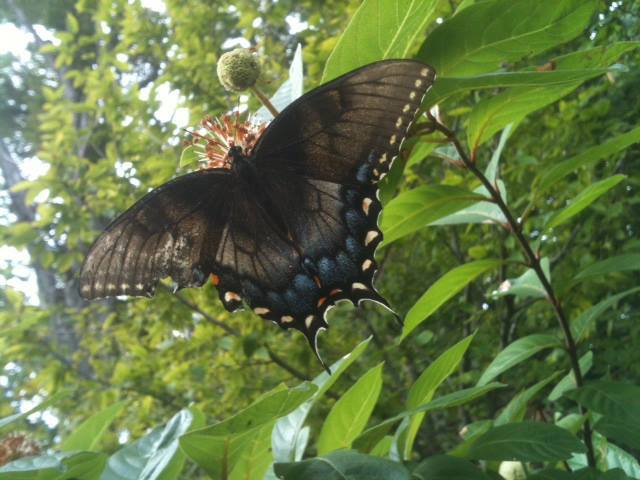In July, Crystal Bridges hosted a “Discover the Grounds” talk about the butterflies that can be found here on our grounds, featuring myself and guest-presenter and ecologist, David Rupe.
I talked about the relationship that insects have with our local ecosystem. I didn’t come with plant examples and descriptions as I usually do; instead, I brought a simple plea: to plant more host plants for butterflies. Host plants are species of plants that butterflies and moths rely on for food and survival. Without these host plants, we lose a vital component of our ecosystem. While many host plants are numerable, some species of butterflies rely on only one species, such as the genus Asclepias (Milkweed) for Monarch butterflies. Our Monarch population is in trouble, and it’s up to us to help! The butterflies must have “fuel” all along their long route to Mexico each year in order to make the journey successfully.Unfortunately, the plants that the Monarch feeds on are declining due to habitat loss and use of herbicides. You can help by planting a “Monarch Way Station,” featuring a mix of milkweed plants and nectar plants. Learn more about the plight of the Monarch, and even order Waystation Seed Kits, at MonarchWatch.org.
Ecologist David Rupe provided an interesting and informative lecture on butterflies. He brought pinned specimens as well as books. David explained the different types of mimicry that butterflies and moths use in order to defend themselves. He also gave insightful details of the Monarch migration and how to attract them to your garden. We were even graced with the appearance of several Swallowtail butterfly species who passed through while the presentation was under way. David provided names of numerous host plants to our local butterflies, with images and a plant list in a beautiful pamphlet. We are truly appreciative for David’s time and knowledge!
 Our next Discover the Grounds program will be Friday, September 13 at 10 a.m. Join us for an up-close and personal look at the birds of prey that inhabit the woodlands of Crystal Bridges. Lynn Sciumbato of Morning Star Wildlife Rehabilitation Center will introduce us to several of her rehabilitation birds. She will discuss their characteristics as well as the role they play within our ecosystem. It’s a rare opportunity to see some of these beautiful birds in person. Hope to see you there!
Our next Discover the Grounds program will be Friday, September 13 at 10 a.m. Join us for an up-close and personal look at the birds of prey that inhabit the woodlands of Crystal Bridges. Lynn Sciumbato of Morning Star Wildlife Rehabilitation Center will introduce us to several of her rehabilitation birds. She will discuss their characteristics as well as the role they play within our ecosystem. It’s a rare opportunity to see some of these beautiful birds in person. Hope to see you there!








